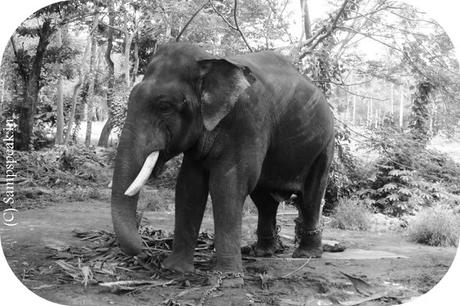
Elephants are very attractive – more so in the wild than in captivity .. sadly its population is plummeting in recent years. Organisations are crying hoarse that Africa is currently experiencing the highest rate of elephant mortality in history, driven largely by a multibillion-dollar illicit ivory trade. Experts have warned that African elephants could become extinct within 10 years. Several hundred are killed every week by well-armed poachers seeking ivory, meat and body parts. Ivory, the hard, white material derived from the tusks and teeth of animals, especially the mammoth elephant is very costly. Whether it is costly or useful ~ it looks good on an elephant and is its body part, not an ornamental piece meant for your display………….. For ages, temple elephants have been a vital part of temple ceremonies and festivals especially in South India. In Kerala, they have a pride of place – as evidenced by the Pooram festivals or the Punnathur kotta, the place for temple elephants at Guruvayoor. Residents of Triplicane will ever remember the great majestic beautiful tusker named “Azhwar” fondly was one who probably never misbehaved. This gigantic one would be bathed, decorated with Thiruman on its forehead and would accompany perumal purappadu. At the end of the purappadu have seen Azhwar offering ‘saamaram’ to Perumal and would walk backwards. It used to carry sacred water (Thirumanjana kudam) from the temple tank, being taken in a procession every morning. Sakrebailu Elephant Camp is located at a distance of 14 Km from Shimoga city on Shimoga -Thirthahalli road. It houses a number of elephants – and this post is of one elephant that was caught in a khedda operation in 1968 in the forest near Kakanakote and brought to Sakrebail the same year. Reports quoting a Sr Vet Officer of the Department of Forest and Wildlife, said the elephant had become senile. Apart from malfunctioning of the digestive system, it was suffering from visual impairment, arthritis and respiratory distress. As the elephant had lost its teeth owing to old age, it was being given cooked food for the past three months. About 10 days ago, the elephant stopped consuming food and vets had to give it fluids and medicines intravenously. The sad news is - Karnataka’s seniormost elephant died on Monday, at the ripe old age of 82. Indira died of natural causes at the Sakrebailu elephant camp, her home for the past almost 50 years. Indira was the grande dame of the Sakrebailu elephant camp, loved by all and known to have tamed many a wild elephant brought here over the past many decades. Indira, forest officials said, was instrumental in taming many wild elephants brought to the Sakrebailu camp, which serves as a rehabilitation and training center for ailing as well as captive pachyderms. There was a steady increase in the number of captive elephants in the camp and Indira played a pivotal role in it. Indira served the department well, ferrying wooden logs and taking part in public events. Her caretakers said she was known for her disciplined nature. Reports from the Hindu and Indian Express state that many mahouts have retired during her stay in the camp. She is that old and so popular. Indira used to be a regular participant in Rajyotsava celebrations, Shivamogga Dasara, nearby fairs, festivals and the camp’s own elephant festival. But over the past two years, she did not take part in any activity due to old age. Yet she was in better health compared to others at the camp. “Her teeth were in much better shape than the younger elephants,” said the mahout who cared for her in twilight days. A vet at the elephant camp in Karnataka state that cared for her put her age at "between 85 and 90". Elephants normally survive to about 70. The last rites were performed in Shettihalli reserve forest on Monday evening, in the presence of senior forest officers and caretakers. With regards – S. Sampathkumar 1st Feb 2017.

